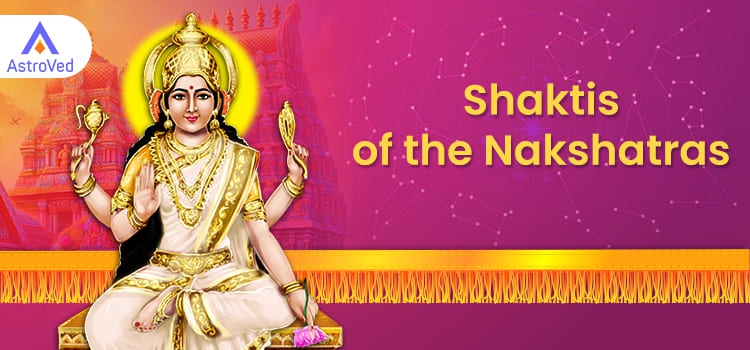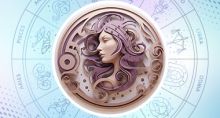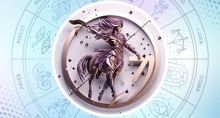Shaktis of the Nakshatras
Nakshatras are lunar constellations or mansions that have great significance in Vedic astrology. There are 27 Nakshatras, each with its own power or Shakti. Their power comes from the Devatas (gods) that rule and define them. Each has both ascending and descending energy.
This special teaching comes from a very ancient Vedic text, the Taittiriya Brahmana I.5.1 and from Bhattabhaskara Mishra’s medieval commentary.
Shaktis of Nakshatras refer to the Moon’s positions mostly. But, they can be extended to the Ascendant and other planets.
Each Nakshatra Shakti has certain effects described symbolically as “above” and “below” and a final effect. The symbols used relate to common factors like plants, worship, healing, marriage, and death.
1. Ashwini – 00 00–13 20 Aries
Ashwini Nakshatra is governed by the Ashwini Kumaras or the twin horsemen. It has the power to reach things quickly or shidhra vyapani shakti. Its basis above is the creatures that need to be healed. Its basis below refers to the healing therapies. From these three, the whole world becomes rid of disease.
Ashwini Nakshatra represents quick aid and energization. It has healing power and can effect quick, radical, and miraculous cures and rejuvenation (rasayana). The Ashwins are forces of Prana (life-force), which acts quickly to stimulate, help, and begin a new level of activity. Ashwini Nakshatra signifies speed, Prana, electrical energy and Shakti.
Ashwini bestows powers of hearing, learning, and attention. It is important for doctors, psychologists, and innovative leaders, as it can provide good insight and original ideas.
2. Bharani – 13 20–26 40 Aries
Bharani’s ruler is Yama, the God of Death. It has apabharani shakti or the power to take things away. Its basis above relates to the removal of life from the body. Its basis below relates to the carrying of the soul to the ancestral realm. Due to the combination of these three factors, all creatures progress to the next world.
Bharani Nakshatra takes away things that have reached the end of their life in order to progress to a new condition. It reveals the soul’s movement away from the body. Yama leads the soul to the astral plane, where it experiences the consequences of its karma from the present life and prepares for the life that is yet to come. Yama represents discipline and sacrifice, and also the practice of Yoga. Bharani Nakshatra has the power to create change by removing whatever is negative or past its time.
Bharani bestows rulership over one’s ancestral legacy as well as lordship over one’s equals.
3. Krittika – 26 40 Aries –10 00 Taurus
Krittika’s ruler is Agni, the God of Fire. It has dahana shakti, or the power to burn and purify. Its basis above is heat, while that below is light. These three factors bring about burning or purification.
Krittika Nakshatra burns up negativity. It purifies what is contaminated, and cooks or prepares that which is unripe. Agni is the deity of the sacred fire, so purification is probably the main action, and not destruction. However, purification does entail the destruction of impurity. Agni is also the fire used to cook food and so it has a nourishing effects, too. This fire’s nature is childlike. Krittika’s power is transformative.
Krittika can destroy negativity, whether it is around us or within our own selves.
4. Rohini – 10 00–23 20 Taurus
Rohini’s ruler is Prajapati, the Creator. It has rohana shakti or growth. Its basis above relates to plants, while that below is the waters. Creation is the result of these three.
Rohini Nakshatra enables growth and creation on all levels. It gives fertility and creativity. However, it can cause jealousy because others can resent those who are given such abundance. It can also boost desire. These are the only side effects of its great prosperity. Prajapati is the creator who can give us everything, so we should be careful about what we desire. Rohini has a benefic nature and the ability to help all projects thrive and ascend.
Rohini grants the power of creation. This includes the ability to come together with friends and loved ones. It is also good for procreation.
5. Mrigashira – 23 20 Taurus–06 40 Gemini
Mrigashira’s ruler is Soma, the deity of the Moon and the immortal nectar. Its power is prinana shakti or giving fulfillment. Its basis above is extension, while that below is weaving (producing clothing), like creating a tapestry to make our life more beautiful.
Mrigashira Nakshatra fills with joy or ananda. It is comparable to a beautiful cloth that makes life more attractive. Soma is something that is won, bought or stolen, so acquiring it is not always easy. This Nakshatra’s power is to bring delight and happiness, that can be therapeutic, rejuvenative, or transformational.
Mrigashira gives control over plants and all things relating to them, including healing.
6. Ardra – 06 40–20 00 Gemini
Ardra’s ruler is Rudra, the fierce form of Lord Shiva, who symbolizes thunder. Its power is yatna shakti or effort, especially for making gains in life. Its basis above is hunting or searching, while that below is reaching the goal. These 3 bring about achievement.
Ardra Nakshatra enables us to make greater efforts in life. It can bring great rewards, but only with persistence and some luck. Rudra is the hunter, one who wields the bow. To hit the target, one should have good aim and the strength to shoot. Rudra is also the god of wild animals. Under this Nakshatra, success is gained only through effort and struggle. However, great achievements are possible.
Ardra bestows rulership over the animals and all that they represent, including the wilder aspects of human nature. Rudra as the hunter also stands for the power of discernment.
7. Punarvasu – 20- 00 Gemini–03 20 Cancer
Punarvasu’s ruler is Aditi, the Great Mother Goddess. It has vasutva prapana shakti or the ability to gain substance or wealth. Its basis above is the Wind or air, and that below is wetness or rain. These enable the revitalization of plants.
Punarvasu Nakshatra enables the return of energy and vitality, similar to the return of the monsoon showers after the dry summer season. It renews our creative growth and inspiration. Aditi is the Earth Goddess. She bestows abundance and gives birth to all the Gods. Her energy is feminine and nourishing.
Punarvasu grants creative and healing powers, especially related to herbs and trees. It is associated with fertility, and relates to the cosmic Mother.

8. Pushya – 03 20–16 40 Cancer
Pushya’s ruler is Brihaspati, the God of Divine wisdom. It has bramavarchasa shakti or the ability to create spiritual energy. Its basis above is sacrificial worship, and that below is the worshipper. These lead to the creation of spiritual energy.
Pushya Nakshatra can boost our good karma and good efforts, including sadhana or yoga practice. It has great value for religious and spiritual practice. Brihaspati is the lord of speech, especially Mantras, prayer, and all kinds of worship, including meditation. Its influence can help one achieve great success with dharmic pursuits.
Pushya bestows spiritual or religious power and authority. It is ideal for teaching, bonding with the guru, ritual, teaching, and devotion.
9. Aslesha – 16 40–30 00 Cancer
Aslesha’s ruler is the serpent God. It has visasleshana shakti or the power to inflict with poison. Its basis above is the serpent’s approach, and that below is trembling and agitation. These cause the destruction of the victim.
Aslesha Nakshatra can paralyze the enemy. This is good if we have enemies, but it can also give one an inimical temperament. It depends on how its energy is used. Serpents also bestow wisdom, but it is a practical wisdom which helps one overcome obstacles. The serpents may belong to the earthly, atmospheric or heavenly realms as electrical forces.
Aslesha grants the ability to destroy enemies and obstacles, whether external or within our psyche.
10. Magha – 00 00 Leo–13 20 Leo
Magha is ruled by the Pitrus or Ancestors. Its basis above is mourning, and that below is leaving the body. It has tyage kshepani shakti, or the power to leave the body. These bring about death.
Magha Nakshatra effects a change of state, a kind of death. Usually, it indicates that we are reaching the end of a cycle. Its condition is prior to that of Bharani, which stands for the movement of the soul away from the body. Higher meanings of this Nakshatra include ancestral pride and power.
Magha bestows the favor of one’s ancestors and the ability to communicate with them inwardly. It reminds us to honor our ancestors and ancestral energies.
11. Purva Phalguni – 13 20–26 40 Leo
Purva Phalguni’s ruler is Bhaga, the solar deity of happiness. It has prajanana shakti or the power of procreation. Its basis above is the wife or female partner, and that below is the male or masculine partner. These help create the fetus.
Purva Phalguni enables union and procreation on all levels. It follows some official agreement or marriage and relates to the creation of a new family or social order. It rules such productive alliances, including the marriage festival. It indicates the need for alliances and unions for success.
The marriage ceremony of the Sun Goddess and the Moon God, or Shiva and Shakti, is celebrated in the month of Phalguni, revealing the importance of balancing male and female energies.
12. Uttara Phalguni – 26 40 Virgo–10 00 Virgo
Uttara Phalguni’s ruler is Aryaman, the God of contracts and unions. It has the power of chayani shakti, which gives prosperity through marriage or union. Its basis above relates to the wealth gained from one’s own family, and that below is the wealth gained from one’s partner. These together enable the accumulation of wealth.
Uttara Phalguni bestows prosperity through union. It indicates the need for union as well as for organizing the resources one gains through it. Bhaga is also a deity of wealth who apportions resources properly. While the previous Nakshatra represents marriage, this represents the setting up of the household for the newlywed couple.
13. Hasta – 10 00-23 20 Virgo
Hasta’s ruler is Savitr, the creative, inspirational, and transformative form of Surya or the Sun God. Its power is hasta sthapaniya agama shakti, or the ability to gain what we are seeking and place it in our own hands. Its basis above relates to the seeking of gain, and that below is the process of gaining. These together place what one seeks to gain in one’s own hands.
Hasta bestows the power to achieve one’s goals in a complete and immediate manner. Such goals tend to be creative. Savitar represents the creative will that designs the universe and all the beauty in it. His productions are exquisite. The indication here is that our creative efforts will be very successful under this Nakshatra’s influence. Savitar also directs and inspires Yoga and the path to enlightenment.
14. Chitra – 23 20 Virgo–06 40 Libra
Chitra’s ruler is Tvashtar, the Cosmic craftsman. Its power is punya cayani shakti or the ability to accumulate merit in life. Its basis above is the law, and that below is the truth. Through these, the worker gains honor in his work.
Chitra enables us to enjoy the fruit of our good karma. It has a very spiritual energy and effect. Tvashtar not only creates enduring forms, like a blacksmith but also creates variety and abundance. He rules over the arts and crafts.
Chitra bestows many progeny or great creativity.
15. Swati – 06 40–20 00 Libra
Swati is ruled by Vayu, the Wind God. It has pradhvamsa shakti, or the power to scatter like the Wind. Its basis above is moving in various directions, and that below is change of form. The result of these is transformation.
Swati Nakshatra makes things move and scatter. This can be destructive unless we can use it to remove negativity. The Wind has both healing and destructive powers. Its influence brings major changes, transformations, and shifts of energy that one must have the power to endure. Then, one can reach a higher level of existence.
Swati grants freedom of motion and travel. It gives the ability to do what we want in all the worlds.
16. Vishakha – 20 00 Libra–03 20 Scorpio
Vishakha’s rulers are Indra and Agni, who symbolize the powers of lightning and heat in the atmosphere. It bestows the power to achieve many fruits in life (vyapana shakti). Its basis above relates to plowing or cultivation, and that below is the harvest. Together, they give the fruit of the harvest.
Vishakha bestows the effort to achieve goals through time, the way a farmer plows his field. There are no immediate results but long term gains. Indra and Agni are agricultural gods who represent the ripening effect of heat, rain and seasonal changes.
Vishakha bestows glory and preeminence among the cosmic powers.
17. Anuradha – 03 20 Scorpio–16 40 Scorpio
Anuradha’s ruler is Mitra, the Divine Friend. It has radhana shakti, or the power of worship. Its basis above relates to ascension, and that below is descension. From these, one gains honor and abundance.
Anuradha Nakshatra bestows balance in relationships, honoring others and trying to be honorable. This brings fame and recognition. Mitra stands for compassion, devotion, and the right relationship. Success comes through honoring the higher powers. We must raise ourselves through our own efforts if divine grace is to descend upon us.
18. Jyeshta – 16 40 – 30 00 Scorpio
Jyeshta’s ruler is Indra, the ruler of the Gods. It has arohana shakti, the power to rise, conquer, and gain courage in battle. Its basis above relates to attack, and that below is defense. They can make one a hero.
Jyeshta empowers us to reach the acme of our powers, but it demands courage and effort. It reveals karmic battles that require us to be completely energized if we are to overcome them. Indra is the ruler of the Gods who must defeat the dragon alone and single handed. Though it looks hopeless, he triumphs by courage and cunning, not by strength. The Nakshatra indicates great struggle and opposition which can be overcome by effort, resolve and independence.
Jyeshta bestows preeminence over others, the ability to eliminate all obstacles and to do our best.
19. Mula – 00 00–13 20 Sagittarius
Mula’s ruler is Nirriti, the Goddess of destruction. It has barhana shakti, or the power to ruin or destroy. Its basis above relates to breaking things apart, and that below is crushing things. These bestow the power to overcome destruction.
Mula Nakshatra brings afflictions but also enables us to destroy their root. It reveals the destruction necessary for a new creation. Nirriti is Alakshmi or the absence of Lakshmi (abundance and prosperity). She is also Kali, the negative effect of time that we need to protect ourselves from or use in a way that benefits us. Mula indicates destruction to make a new creation possible.
Mula bestows the power to get to the root of things and connect with primordial creative powers.
20. Purvashadha – 13 20–26 40 Sagittarius
Purvashadha’s ruler is the Waters (Apas). It has varchograhana shakti or invigoration. Its basis above relates to strength, and that below is connection. They bestow luster.
Purvashadha enables purification and regeneration, like the energy we get by bathing in water. It gives us more power for our efforts. These effects flow from the Waters, which are heavenly in nature and make possible inner purification. It indicates cleansing and purification to gain what we seek.
Purvashadha bestows a connection with the sea and the ability to cross the ocean (which has many symbolic meanings, like crossing over illusion).
21. Uttarashadha – 26 40 Sagittarius–10 00 Capricorn
The Universal Gods (Vishvedevas) rule Uttarashadha. Its power is apradhrisya shakti or the ability to grant an unchallengeable victory. Its basis above is related to the strength to win, and that below is the goal that one can achieve. These enable one to become the unchallenged winner.
Uttarashadha helps us achieve the summit of our power, support and recognition. But it is not so much through our personal efforts. It involves alliances and the support of all the deities. Our victory rests on a righteous cause that benefits all. One’s role is like the leader of an army, who works for the greater victory. It indicates great achievements from long term efforts.
Uttarashadha bestows the supreme victory that cannot be taken away. It enables us to reach our highest goals.
22. Shravana – 10 00–23 20 Capricorn
Shravana’s ruler is Vishnu, the Preserver deity, here in the form of Vamana or Trivikrama. It has the power of connection (samhanana shakti). Its basis above relates to seeking, and that below are the paths. The three result in the connection of all things.
Shravana helps unite people by connecting them to suitable life paths. This calls for receptivity and listening, and leads to understanding and aspiration. Vishnu took 3 steps to link together Earth, Atmosphere, and Heaven, connecting all beings with the Divine. It indicates the importance of knowledge, teaching, and communication. Without these, our efforts will fail.
Shravana makes others speak well of us and enables us to hear their praises.
23. Dhanishta – 23 20 Capricorn–06 40 Aquarius
The eight Vasus, the deities of abundance that rule the earth, rule Dhanishta. Its power is khyapayitri shakti, or the ability to bestow abundance and fame. Its basis above is birth, and that below is prosperity. These three bestow the power to bring people together.
Dhanishta enables us to bring together the resources of people. In this manner, it builds upon the connections of Shravana and makes them more practical. The Vasus bestow abundance on the earthly plane and are manifestations of Agni or the sacred fire. They reveal the gifts Agni can dispense. Dhanishta bestows outer success and a lot of recognition.
Dhanishta enables us to become the center of attention among friends and peers.
24. Shatabhishak – 06 40 –20 00 Aquarius
Shatabhishak’s ruler is Varuna, the God of the cosmic waters. Its power is bheshaja shakti, or the power of healing. Shatabhishak means ‘holding a hundred medicines’. Its basis above relates to extension or pervasiveness over all, and that below is the support of all. These three rid the world of calamity.
Shatabhishak helps one counter difficult karmas through god’s grace and repentance. These may include diseases or other difficulties. While Ashwini gives quick cures, Shatabhishak effects a healing crisis that leads to revitalization. Varuna is a deity of sin, debts, injury and disease. He can make us suffer these calamities and also remove them, if we appease him. This is a major Nakshatra for physical and psychological healing.
Shatabhishak enables us to become strong and firm and helps us overcome weaknesses.
25. Purva Bhadra – 20 00 Aquarius–03 20 Pisces
Purva Bhadra’s ruler is Aja Ekapad, the one-footed goat or serpent. It has yajamana udyamana shakti or the fire to elevate a spiritual person in life. Its basis above relates to the good of all, and that below is what is good for the Gods. These help support the entire world.
Purva Bhadra gives one a universal view through inner purification. This elevates our spiritual aspiration in life and gets rid of our selfish behavior. Aja Ekapad is the celestial form of Agni, the sacred fire, that is sometimes identified with the Sun, reflecting the Kundalini Shakti as well. It transforms us through spiritual effort, discipline and tapas.
Purva Bhadra provides creative fire and spiritual radiance, similar to Pushya.
26. Uttara Bhadra – 03 20–16 40 Pisces
Uttara Bhadra’s ruler is Ahir Budhnya, the serpent of the depths of the atmosphere. Its power is varshodyamana shakti or the bringing of the rain. Its basis above relates to the raining clouds, and that below is growing of the plants. These three factors bring stability to the three worlds.
Uttara Bhadra bestows broad-based growth and prosperity that benefits the entire world. So it is very auspicious. Ahir Budhnya is the benefic serpent. It brings the rain, connecting us with the creative powers that constitute the world’s foundations. The Nakshatra helps things to grow and reveals the descent of grace from above.
Uttara Bhadra bestows a firm foundation in life.
27. Revati – 16 40–30 00 Pisces
Revati is ruled by Pushan, the nourishing form of Surya or the Sun God, identified with the power of seeing. It has kshiradyapani shakti, or the power of nourishment represented by milk. Its basis above is related to cows, and that below are the calves. These three enable the nourishment of the whole world.
Revati ensures abundance by providing nourishment, and helps people in their efforts. Pushan is the god of cattle and the lord of the paths. He leads, gathers, and protects the herd in their movement, especially to new pastures. In this manner, he also safeguards the soul in its journey to the next world. Revati promotes fertility and growth, grants abundance, and enables completion of our projects.
Revati bestows power over cattle and sources of nourishment. Cattle also signify what we have seen and experienced.




















